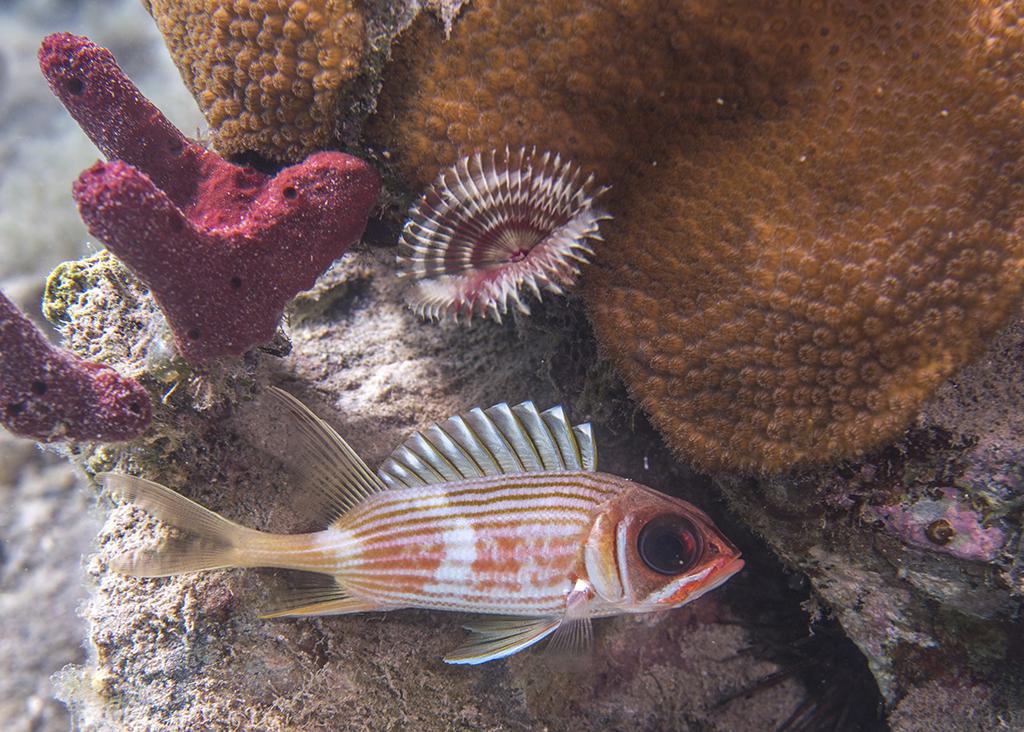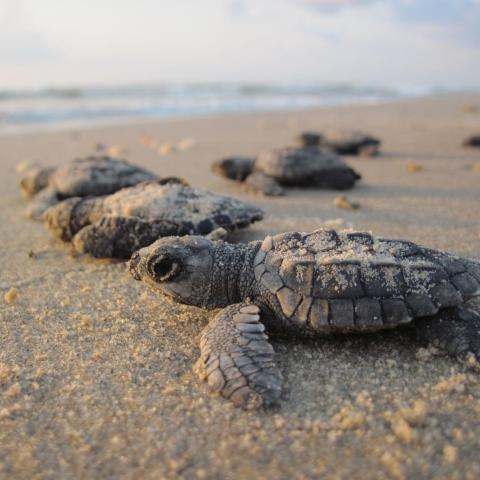
A couple of Sandwich terns enjoying the beach life at Padre Island National Seashore / Rebecca Latson
Here to test your national parks knowledge is the last quiz and trivia piece for 2024. How much do you really know about units of the National Park System? Perhaps more than you realize. Try to answer these questions before looking at the answers at the bottom of this piece. You might learn something new!
1. Padre Island National Seashore in Texas is a birder’s (and bird photographer’s) paradise, with over 380 species living at this national seashore or stopping for a spell before moving to the next spot during their migration. One of the birds you might see during a visit is the Sandwich tern. True or False: Sandwich terns get their name from the town of Sandwich in County Kent, England, where this tern was first discovered.
a) True
b) False

A couple of sandwich terns enjoying the beach life at Padre Island National Seashore / Rebecca Latson
2. While exploring Big Bend National Park along the Ross Maxwell Scenic Drive in Texas, you might come across the sight of a tarantula crossing the road. Tarantulas are hairy, with dense, bristly legs. Those leg hairs serve a purpose:
a) To keep the tarantula warm during the winter
b) To latch on and help slough off the tarantula’s skin when it molts
c) To detect tiny vibrations and sense movement on the ground
d) To latch on and hold down their prey while feeding

A bubblegum-pink flying squirrel / David Moskowitz, PhD, via DOI Instagram
3. Wheeee! How many of you have ever seen a flying squirrel? They are common in the Pacific Northwest and you might see them at Olympic National Park in Washington State – if you stay up late enough. Flying squirrels are nocturnal, meaning they are most active at night. Did you know they glow bright pink when UV (ultraviolet) light is shone on them? This phenomenon is called ___.
a) Bioluminescence
b) Fluorescence
c) Phosphorescence
d) Luminescence

A view across the dig shelter at Waco Mammoth National Monument / Jim Stratton
4. Visit Waco Mammoth National Monument in Texas, and you’ll learn about the discovery of mammoth fossils representing the nation's first and only recorded evidence of a nursery herd of ice age Columbian mammoths. These behemoths stood as tall as 14 feet (4.3 m) and weighed ___ pounds.
a) 5,000
b) 10,000
c) 15,000
d) 20,000

A hummingbird clearwing moth, Cuyahoga Valley National Park / Michael Silvestro via NPS
5. Visit Cuyahoga Valley National Park in Ohio, and you might be fortunate enough to see a hummingbird clearwing moth hovering around a wildflower. Listen carefully and you might even hear its rapid wingbeats create a humming sound. These moths are also known as ____.
a) Buzz moths
b) Hawk moths
c) Bird moths
d) Sphinx moths

Longspine squirrelfish, Virgin Islands National Park / NPS - Susanna Pershern
6. Snorkel the coral reefs at Virgin Islands National Park and you might chance upon a longspine squirrelfish. There are about ___ species of squirrelfish and their most distinguishing characteristics are their very large eyes and the long spine of the anal fin.
a) 100
b) 125
c) 150
d) 175

Sarcoscypha coccinea, Mount Rainier National Park / NPS - C. Vecchio
7. Say hello to Sarcoscypha coccinea, a fungus that typically fruits in the cooler months of winter and early spring, and may be found at Mount Rainier National Park in Washington State within damp woodlands where there is an abundance of forest debris. S. coccinea is also known as ___.
a) Scarlet elf-cup
b) Claret cup
c) Wine cup
d) Mead cup

Windsurfing in Bird Island Basin along the Laguna Madre, Padre Island National Seashore / NPS - Mimi Gorman
8. Laguna Madre at Padre Island National Seashore is one of ___ hypersaline (saltier than typical seawater) lagoon/bays in the world.
a) Five
b) Six
c) Seven
d) Eight

A forest full of ferns and other vegetation, Redwood National and State Parks / Rebecca Latson
9. Visit any part of Redwood National and State Parks and you will be surrounded by vegetation. As a matter of fact, there are ___ plant species documented within this mosaic of parks located in Northern California, including the endangered beach layia (Layia carnosa).
a) 733
b) 816
c) 881
d) 922

An ice-cold river flowing through North Cascades National Park / Rebecca Latson
10. True or False: Of the major watersheds flowing from the rugged mountains of North Cascades National Park into Puget Sound in Washington State, the Nooksack River and its tributary streams is the largest watershed.
a) True
b) False
Trivia

Autumn green and gold, Devils Tower National Monument / NPS file
Fall is almost finished and most of the trees are bare. Well, the deciduous trees are, anyway. If you visited a park like Devils Tower National Monument during the autumn months, you might have noticed not all of the trees were changing color. Some trees – the coniferous trees – remained green. Why is this?
The leaves on deciduous trees contain chlorophyll, which absorbs energy from the sun via photosynthesis and stores that energy in the tree during the winter months. Chlorophyll doesn’t absorb the green wavelengths in white light, instead reflecting it to make the leaves look green. During the fall, there is less sunlight and the chlorophyll breaks down, allowing other pigments (yellow, orange, red) in these deciduous trees to be exposed.
Coniferous trees, on the other hand, do not contain these same color-changing compounds. Their needles can photosynthesize year-round. The only time the needles change from green to brown is after they have grown old and fallen from the trees. How can coniferous needles continue to photosynthesize during the harsh months of winter, when deciduous trees cannot? Their needles have a waxy coating and also have an inner fluid resistant to freezing – a natural antifreeze.

Fighting bull elephant seals, NMFS Permit No. 21425, Point Reyes National Seashore / NPS-PRNSA-Aiko Goldston
How many of you have ever viewed the humongous elephant seals at Point Reyes National Seashore in California?
According to park staff:
After being absent for more than 150 years, northern elephant seals returned to sandy pocket beaches on the south side of the Point Reyes Headlands in the early 1970s. In 1981, the first breeding pair was discovered near Chimney Rock. Between 1988 and 1993, the population grew at a dramatic annual average rate of 32 percent. Since 1993, the average growth rate has slowed to 8–9 percent per year. Fanning out from their initial secluded south-facing beaches of the headlands, the seals have since expanded to beaches which are not as remote, including, after 2019, Drakes Beach adjacent to the Kenneth C. Patrick Visitor Center.
While some elephant seals call this national seashore home throughout the year, December through March is when you will see large numbers of these behemoths, which is their birthing and mating season.
To learn more about the elephant seals, you can listen to the Traveler’s Podcast Episode 305 and/or read this Traveler article.

Settlers and their cabin circa 1900, North Cascades National Park / NPS file
The North Cascades National Park Complex is a rugged environment, and people who chose to settle there were tough and tenacious.
According to park staff:
Settlement [occurred] along the three major river systems, the Stehekin, Cascade and Skagit, [and] continued through the 1880s … The majority of early settlers were not farmers but shopkeepers and innkeepers who came to sell goods and services to the trappers and prospectors who first ventured up the rivers. Close to the mouth of the Stehekin River was the final stop for steamboats bringing prospectors and their supplies up Lake Chelan. Prospectors stayed in a small boarding house called the "Argonaut" before venturing into the mountains. The boarding house was sold in 1892 to M. E. Field who eventually transformed it into a 25-room hotel. By 1902, the town of Stehekin had formed with a post office and schoolhouse. Marblemount, at the confluence of the Cascade and Skagit rivers, was established as a base for miners; the first wagon road was built into the area in 1892.
Quiz Answers
1a True
Sandwich terns were named after the town of Sandwich in County Kent, England, where they were first discovered. They are a common sight on Padre Island National Seashore’s beaches during the summer.
2c
The bristles on a tarantula’s legs are like listening devices, detecting vibrations on the ground and allowing them to ambush their prey rather than chase them down.
3b
In 2019, a chance encounter with a flying squirrel and an ultraviolet flashlight surprised a college professor when his light caused that squirrel to glow a bright bubblegum pink. This is known as fluorescence, which is the ability of certain chemicals to give off visible light after absorbing radiation which is not normally visible, such as ultraviolet light. In the case of the flying squirrel, we see that visible light as bright pink!
4d
Columbian mammoths could weigh up to 20,000 pounds. Thousands of years ago, they roamed the landscape of what is now the state of Texas. Click here to read a Traveler article about Waco Mammoth National Monument. You can also learn more about this national monument by listening to the Traveler’s Podcast Episode 205.
5b
Hemaris thysbe, the hummingbird clearwing, is a moth of the family Sphingidae (hawk moths). Beating its wings rapidly, H. thysbe hovers to collect nectar from a variety of flowers. The combination of its appearance and its behavior commonly leads to it being confused with a hummingbird or bumblebee.
6c
There are about 150 species of squirrelfish and their most distinguishing characteristics are their very large eyes and the long spine of the anal fin. According to Wikipedia, “The squirrelfish is territorial and uses grunt and staccato sounds to defend its crevice, warn of danger and, in groups, intimidate predators such as the moray eel."
7a
According to Mount Rainier National Park staff, “Often, only the cup of Sarcoscypha coccinea is visible through the leaf litter, but deeper down, the fungus will always be attached to a piece of decaying wood, its preferred substrate. The lower surface of the cup is covered with fine hairs ("tomentum") and the stipe (stalk), when present, is also tomentose. Younger specimens may not exhibit a stipe. Sarcoscypha coccinea is also known as Scarlet Elf-cup.”
8b
On the western side of Padre Island rests the Laguna Madre, one of six hypersaline lagoon/bays in the world. Its shallow waters, averaging about 3.6 feet deep (1.1 m).
9b
There are 816 documented plant species (621 native; 195 exotic) living within Redwood National and State Parks.
10b False
Several major watersheds flow from the North Cascades including those of the Skagit, Stehekin and Nooksack rivers. The Skagit River and its tributary streams comprise the largest watershed draining into Puget Sound.




 Support Essential Coverage of Essential Places
Support Essential Coverage of Essential Places






